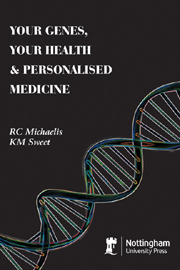Book contents
- Frontmatter
- Contents
- INTRODUCTION
- 1 UNDERSTANDING THE MEANS BY WHICH OUR GENES INFLUENCE OUR HEALTH
- 2 THE MECHANISM WHEREBY A GENE MAKES ITS PROTEIN
- 3 UNDERSTANDING THE PRINCIPLES OF INHERITANCE
- 4 USING YOUR FAMILY HISTORY INFORMATION TO PREDICT YOUR RISK FOR SPECIFIC DISEASES
- 5 USING GENETIC TESTING TO MAINTAIN YOUR HEALTH AND PERSONALISE YOUR MEDICAL CARE, NOW AND IN THE FUTURE
- 6 MAKING THE DECISION WHETHER OR NOT TO HAVE GENETIC TESTING, AND INTERPRETING THE RESULTS OF TESTS YOU CHOOSE TO HAVE PERFORMED
- 7 NUTRIGENOMICS AND EPIGENETICS: THE EFFECTS OUR DIET, ENVIRONMENT AND LIFESTYLE HAVE ON OUR GENES AND PROTEINS
- EPILOGUE AND USEFUL INTERNET RESOURCES
- INDEX
6 - MAKING THE DECISION WHETHER OR NOT TO HAVE GENETIC TESTING, AND INTERPRETING THE RESULTS OF TESTS YOU CHOOSE TO HAVE PERFORMED
- Frontmatter
- Contents
- INTRODUCTION
- 1 UNDERSTANDING THE MEANS BY WHICH OUR GENES INFLUENCE OUR HEALTH
- 2 THE MECHANISM WHEREBY A GENE MAKES ITS PROTEIN
- 3 UNDERSTANDING THE PRINCIPLES OF INHERITANCE
- 4 USING YOUR FAMILY HISTORY INFORMATION TO PREDICT YOUR RISK FOR SPECIFIC DISEASES
- 5 USING GENETIC TESTING TO MAINTAIN YOUR HEALTH AND PERSONALISE YOUR MEDICAL CARE, NOW AND IN THE FUTURE
- 6 MAKING THE DECISION WHETHER OR NOT TO HAVE GENETIC TESTING, AND INTERPRETING THE RESULTS OF TESTS YOU CHOOSE TO HAVE PERFORMED
- 7 NUTRIGENOMICS AND EPIGENETICS: THE EFFECTS OUR DIET, ENVIRONMENT AND LIFESTYLE HAVE ON OUR GENES AND PROTEINS
- EPILOGUE AND USEFUL INTERNET RESOURCES
- INDEX
Summary
Making The Decision Whether Or Not To Have Genetic Testing
Personalised Medicine Encourages You To Take A More Active Role In Maintaining Your Health
Personalised medicine aims to individualise health care, rather than having doctors treat everyone with a particular disease with the same treatment plan. The personalised medicine tests of the future will combine information about your personal health history, family history, age, gene sequences, medical information such as blood sugar or cholesterol level, diet, environment and lifestyle. By assessing this information for each individual patient, doctors will be better able to predict the individual's risk for specific diseases, as well as diagnose diseases more confidently. In addition, in some cases this information will enable your doctor to design the safest and most effective treatment plan for you when you get sick.
Personalised medicine will not just enable your doctor to do his/her job better; it will help you maintain your own health more effectively. Genetic and nongenetic factors interact to influence our risks for many of the most common diseases. Thus, if you know the diseases for which you have the greatest genetic risk, you may be able to minimise your exposure to some of the nongenetic factors that increase your risk of developing that disease. In some cases, personalised medicine tests may enable you to avoid developing a specific disease entirely. In other cases, the information may allow you to delay the onset of the disease, or reduce the severity of the disease.
- Type
- Chapter
- Information
- Your Genes, Your Health and Personalised Medicine , pp. 107 - 132Publisher: Nottingham University PressPrint publication year: 2011
- 1
- Cited by

